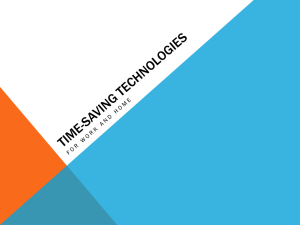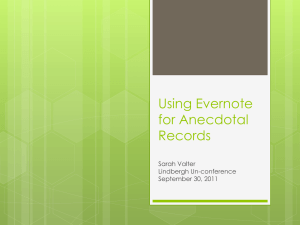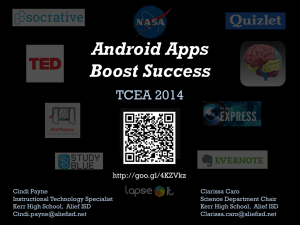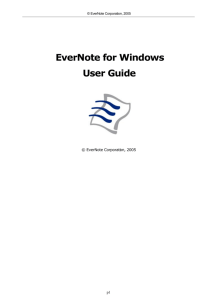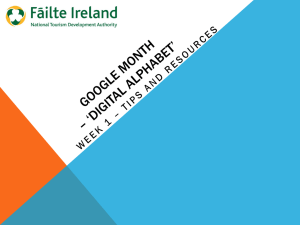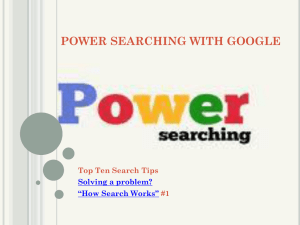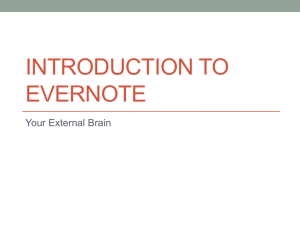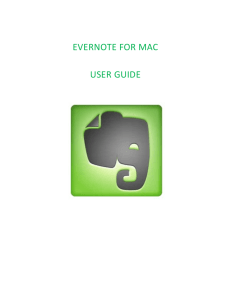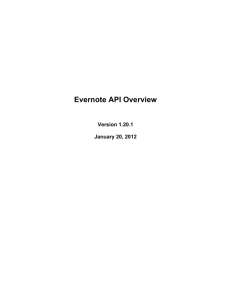Using Evernote and Google Docs in your web or
advertisement
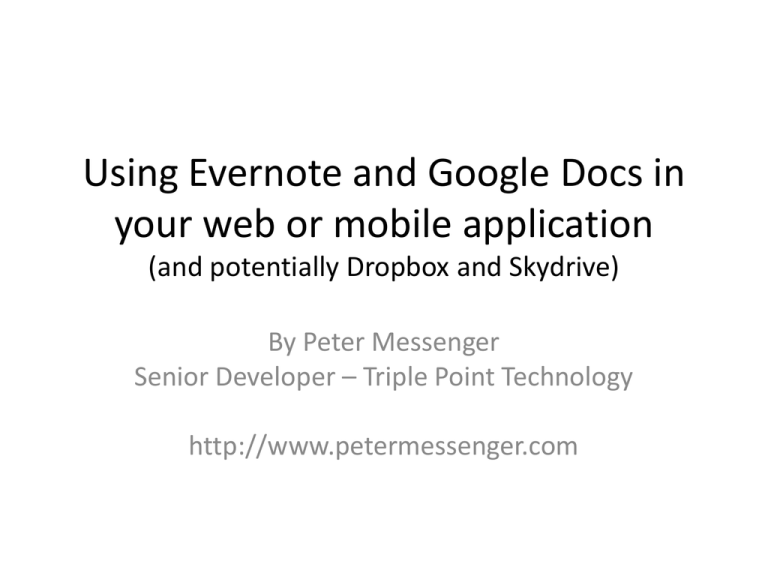
Using Evernote and Google Docs in your web or mobile application (and potentially Dropbox and Skydrive) By Peter Messenger Senior Developer – Triple Point Technology http://www.petermessenger.com Why use cloud based storage? • Large user base – Evernote more than 10 million installs on android per month – Dropbox has more than 100 million users – Skydrive has more than 200 million users • Makes it easier for user, can be used anywhere • Previously would output to PDF or RTF (RTF had issues on IOS/Mac OS as they store images differently and you cannot generate files that will work correctly) What is Evernote? • Evernote allows you to generate notes, save webpages and collaborate with others • Free and paid versions available • Website : http://evernote.com/ • Available natively on all major mobile devices (IOS, Android, Blackberry, Windows Phone) • Available on the web and desktops (Mac OS, Windows, Windows 8 and browsers) • Uses XML to store documents, very similar HTML Evernote Development • Has an API interface to integrate with server • Sdks – Android, IOS, C#, C++, Java, Python, Perl, Ruby and more • Website : http://dev.evernote.com/ • Need a developer token, gives access to sandbox (test server), once complete you email support and they switch to production • For simplicity, used the C# sdk – https://github.com/evernote/evernote-sdk-csharp Demonstration • Website – http://www.physiotherapyexercises.com • Uses a single page in the background to connect to evernote, generate the document and copy it back to the server • Integrates into website quite well • Was using XML transforms to generate HTML previously, created a new transform to generate evernote document format Connecting to Evernote • Evernote supports the same standard OAuth authentication process used by other popular web services like Twitter and Google. • Details : – http://dev.evernote.com/start/core/authenticatio n.php • Used a helper library for this – https://github.com/danielcrenna/oauth Connecting to Evernote • Connect to server passing in – Username and password – Callback url • User is taken to logon page, assuming they accept, returns temporary token details to your callback url (this temporary token can last for a long period) • Connect to server again using temporary tokens, get authorisation token • Generate note using authorisation token, get note id, redirect to evernote account so user can view document Connecting to Evernote Evernote document format • Xml, can include attachments • http://dev.evernote.com/start/core/enml.php <en-note> <h1>Hello, world</h1> <en-media width="640" height="480" type="image/jpeg" hash="f03c1c2d96bc67eda02968c8b5af9008"/> </en-note> • Hash is the unique identifier for the resource attachment to the note • Supports a whole range of HTML elements Android Demonstration • Shows how you can use the same api in an android app • Could also do this using android sdk and/or check to see if the user had evernote installed on their phone and open it using the android version rather than the website Google Docs/Google Drive • Google’s equivalent to microsoft word • Similar to evernote, documents are stored in a variant of HTML • Can then use drive to output to different formats (PDF, Word etc – can be a bit flaky with formatting) • API supports Java, PHP, Javascript, NET, Objective C, Android, Ruby etc • Website : https://developers.google.com/drive/ Google Drive • Quick start for C# – https://developers.google.com/drive/quickstart-cs • Enable Drive API – https://code.google.com/apis/console/ – Much like evernote, you need a callback url (this is case sensitive and passing in parameters doesn’t seem to work fully, so use session variables) – Unlike evernote, the callback url must be specified in the google console • Install the Google Client Library Google Drive • C# example is for MVC and massively overcomplicates what you need to do • Can pretty much ignore 99% of the example and just use the googleutils class. • You need to store the user credentials in a database or on the server • Uses Oauth, but simpler and all built into library Demonstration • Website – http://www.physiotherapyexercises.com • Uses a single page in the background to connect to google drive, generate the document and copy it back to the server • Integrates into website quite well • Was using XML transforms to generate HTML (slightly different to get around formatting limitations) Generating Document • Can pass in HTML and use the in built conversion routine to save in google docs format • Formatting of tabular data is quite problematic as you can only have one cell style, so end up having tables inside tables to get around it. Dropbox and Skydrive Have not implemented these yet (as they are more generic storage options), but they use the same concepts. • Dropbox – https://www.dropbox.com/developers/reference/sdk – IOS, Android, Python, Ruby, Java, OS X – Several third party libraries (php, net, js etc) • Skydrive – http://msdn.microsoft.com/enus/library/live/hh826521.aspx Questions? • Presentation slides on my website and blog – http://www.petermessenger.com
